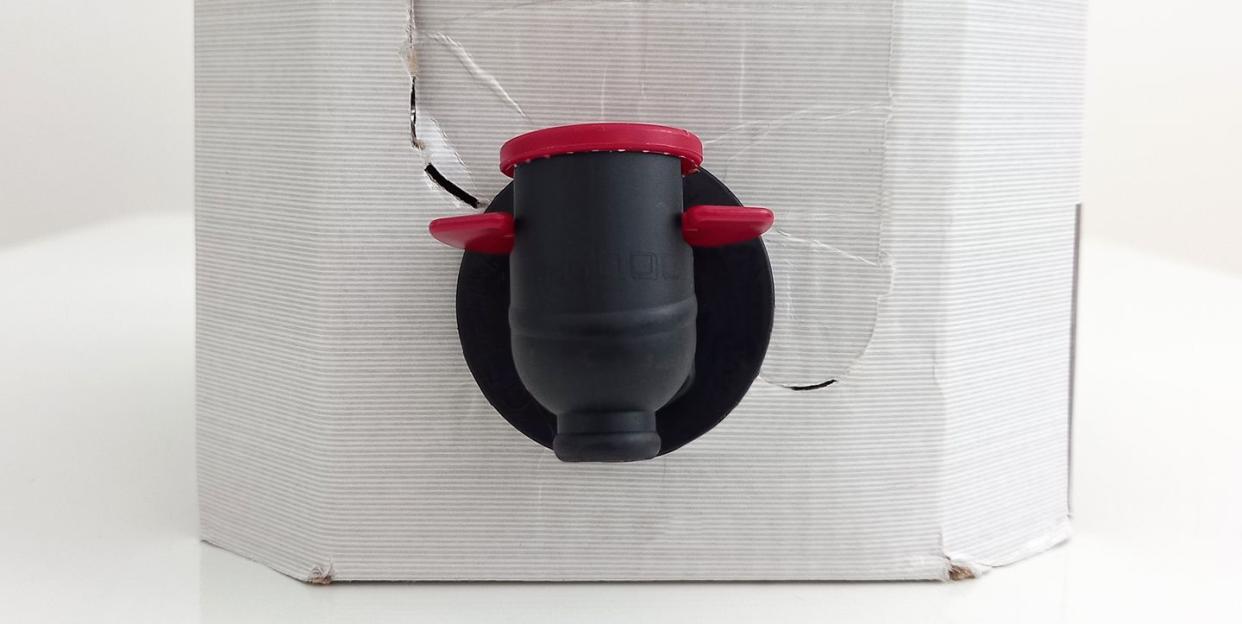We Tried Boxed Wine and...We're Pleasantly Surprised

"Hearst Magazines and Yahoo may earn commission or revenue on some items through the links below."
What was your first experience of boxed wine? Was it sampling an aunt's supply of the pink stuff from her fridge? Did you grab a stylish looking box from the grocery store for a cookout? Or perhaps you were at a party, and noticed a box sitting near the beer cooler, and decided to give it a try.
Whatever it was, chances are good you weren't particularly amazed.
Boxed wine has a rep for being plonk—drinkable, sure, but nothing you'd try to impress a guest with. That's a shame, because boxed wine can be not only as good as, but better than bottled wine—and a much better value for your money.
To understand why, it helps to know what goes into the cost of a bottle of wine, as well as what happens after you open it.
Let's start with the cost part, first: Bottles are a big expense. Though they look beautiful (and have been storing wine for centuries) glass wine bottles aren't great. They're heavy to ship and transport—accounting for around 40% of a case's total weight. Being glass, they're also brittle, so winemakers have to factor in the number of bottles they expect will break—what's called, conveniently, "breakage" when calculating how much to charge. It's not hard to see that lighter, sturdier packaging could significantly reduce prices.
And while it doesn't have to be outrageous, decent wine can't be cheap. In general, in 2022, while you can buy a bottle of wine for under $10, it's probably not worth it. The costs of growing grapes, juicing them, fermenting them, and turning them into a drinkable wine means, that, on average, if a bottle of wine costs less than $10 a whole lot of corners are being cut.
For $15-$20, you typically get a very big jump in quality. There's a smaller jump in quality, frankly, that can (but doesn't always) come from spending $20-$30. After that the price often has more to do with rarity, reputation, or status than anything else.
This means that most boxed wine is too inexpensive. Boxes of wine are typically about three liters — equal to four 750ml bottles. If the box you're buying costs $30, then you're paying an average of $7.50 per bottle. Even after accounting for shipping charges, that's not quite enough to get you anything of quality.
But if you pay twice that, around $60 a box, then you're at about $15 a bottle — and because you're still saving on shipping expenses, you're more likely to get wine that would cost closer to $20 or more per bottle if you bought it in glass.
And then there's what happens after you open it. Whether you prefer red, white, or rosé, you're probably aware that an open bottle of wine tastes different the next day — a little flatter, not quite as flavorful. That's because an open bottle of wine is not terribly shelf stable. Once air touches it, it begins to oxidize. After a few days sitting around, even in the fridge, it can be closer to vinegar than something you'd want to drink with dinner.
What this means, of course is that as soon as you open a bottle of wine, the clock begins ticking. If it's a nice bottle, there's pressure to finish it before it goes bad. That's one thing if you're at a dinner party with a bunch of friends, but it's something altogether different if you're just looking to have a glass with dinner to wind down at the end of a day, and don't want to wake up feeling hung over. It could take you a week to finish the bottle if you're drinking a glass a night.
Boxed wine has a major advantage here, because the wine is actually situated in a bag, which contracts as the wine comes out of the spout. Boxed wine can be opened and poured out glass by glass, and it will remain drinkable it for weeks. And while a vacuum bottle sealer is an option to extend the life of your bottled wine, it's not nearly as efficient as the technology boxed wine uses.
We tested this recently, at the Country Living offices. We opened a box of 2019 Cabernet Sauvignon from Really Good Boxed Wine and six different editors sampled it across five weeks, tasting and taking notes. The grapes were grown in Paso Robles, CA, from a single vineyard. And the wine was more than just drinkable—it was something you could taste, and talk about.
The box claimed "black cherry, plum, clove, and toffee" flavors. We all noticed plenty of berry and cherry, though not much toffee, with a balance of tannins and acids. Over the weeks, the flavors certainly changed — editors found the heat from the alcohol growing, and notes of chocolate starting to develop, along with a more pronounced plum. But most agreed they would still happily serve it to guests, even five weeks after opening. And at roughly 20 glasses per box, that gives you a good long time to enjoy it, without worrying about waste.
Really Good Boxed Wine retails for about $65 per box, including shipping. You can buy a box directly on their site, or subscribe and receive a box every month.
You Might Also Like

